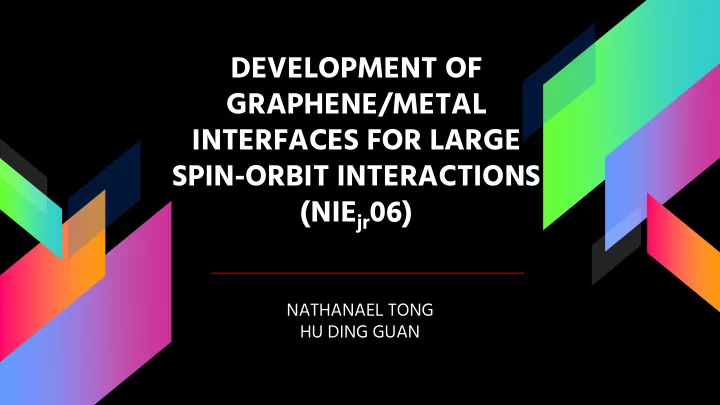

DEVELOPMENT OF GRAPHENE/METAL INTERFACES FOR LARGE SPIN-ORBIT INTERACTIONS (NIE jr 06) NATHANAEL TONG HU DING GUAN
Presentation Flow Background ● Aims & Objectives ● Methodology ● Results & Discussion ● Conclusions & Further Research ● 2
BACKGROUND 3
Graphene Monolayer sheet of sp 2 bonded carbon atoms. ● σ bonds between neighbouring carbon atoms ● due to overlapping sp 2 orbitals Bonding energies of neighbouring C pz orbitals of ● each carbon atom form the π and π * states. π σ C 1 C 2 π 4
Band theory Solid state objects follow band theory ● conductivity is based on its electrons’ quantum states Free movement of electrons = conduction ● Conductor Semiconductor Insulator Conduction band Conduction band Conduction band Band gap Valence band Valence band Valence band 5
Band theory Linear distribution of band structure ● valence & conduction bands meet Formation of Dirac cones ● Little energy is required for electrons ● to move freely between the 2 bands 6
RESEARCH GAP The absence of a band gap in graphene makes it ● difficult to show contrast between the graphene transistors on/off states 7
Band bending At the junction of an interface, the phenomenon of ● band bending at the Fermi Level is observed. Difference in work functions of metal ( ϕ M ) and ● graphene ( ϕ G ) Induces a local barrier height ( ϕ BH ) = band gap ● of the graphene 8
AIMS & OBJECTIVES 9
Create a substrate-induced band gap in graphene and Compare induced band gaps across different metal interfaces
METHODOLOGY 11
METHODOLOGY CVD graphene growth PMMA-assisted wet transfer Obtain Gr/Metal interface 12
CHEMICAL VAPOUR DEPOSITION (10 sccm) (2 sccm) 60 minutes 1100°C 13
SOLVENT ETCHING AND TRANSFER Etch Cu Spin coat ● ● substrate with Poly(Methyl- FeCl 3 solution methacrylate) layer onto Cu/Gr Transfer ● graphene layer onto substrate manually 14
RESULTS AND ANALYSIS 15
RESULTS & ANALYSIS Scanning Electron Microscopy Raman Spectroscopy I-V Measurements I-Z Spectra 16
SCANNING ELECTRON MICROSCOPY Using Scanning Electron Using the images taken, Microscope (SEM) we were able to identify imaging, we took high any visual defects on the magnification images of graphene surface. our graphene samples. 17
SCANNING ELECTRON MICROSCOPY SEM image of ITO/Gr (x600) SEM image of Cu/Gr (x600) 18 SEM image of Pt/Gr (x600) SEM image of W/Gr (x600)
SCANNING ELECTRON MICROSCOPY SEM image of Cu/Gr (x2,000) SEM image of ITO/Gr (x2,000) 19 SEM image of Pt/Gr (x2,000) SEM image of W/Gr (x2,000)
RAMAN SPECTROSCOPY Using Raman These principle peaks tell Spectroscopy, we us more about the quality characterized the G and 2D of our graphene samples, peaks of graphene in our and helps us confirm our samples. samples are actually graphene. 20
RAMAN SPECTROSCOPY Si ITO SiO 2 W Pt 21
I-V CHARACTERISTICS Using a 2 probe method, We plotted the voltage (V) we measured the I-V as a function of current (A) characteristics of the to obtain a linear graph. graphene samples. 22
I-V CHARACTERISTICS W SiO 2 Si Cu ITO Pt 23
I-V CHARACTERISTICS Taking the relationship ● Substrate Resistance/ Ω 𝑊 Pt 4012 𝐽 , we can deduce 𝑆 = the resistance of the W 2919 graphene layer on the Cu 4746 substrate ITO 3413 Si 5041 SiO 2 6655 24
I-Z SPECTRA Using a Scanning The I-Z spectras yield Tunneling Microscope information on the local (STM), we obtained the I-Z barrier height (band gap) spectra of the graphene of the graphene samples samples. 25
I-Z SPECTRA From the quantum tunneling principle, the relationship ● between the magnitude of the tunneling current ( I(Z) ) and the tip sample distance ( 𝑨 ) can be expressed as I(z) ∝ 𝑓 −2 𝜆𝑨 , where κ (decay constant), dependent on the barrier height ( ϕ BH ), is given as κ = 5.1 √ ϕ BH (eV ) nm −1 26
I-Z SPECTRA By taking 𝑨 as a function ● Substrate Barrier of ln[I(Z)] , we obtain a height/eV linear graph with a Pt 0.4 gradient of -2 𝜆 W 0.7 Undoped 0.1 The barrier height ( ϕ BH ) ● Graphene can hence be calculated. 27
CONCLUSIONS & FUTURE RESEARCH 28
CONCLUSIONS Graphene quality consistent with literature ● Successfully induced band gap in interface ● Band bending at Fermi level Possible utility in spintronic devices 29
CONCLUSIONS Defects caused during manual transfer ● a relatively small band gap induced in pure, un-doped graphene Contact resistance between probe & graphene ● Uncertainty of recorded resistance 30
FURTHER RESEARCH Measurement of electron mobility & quantum spin- ● hall effect Ultraviolet Photoelectron Spectroscopy (UPS) ● X-ray Photoelectron Spectroscopy (XPS) ● 31
ACKNOWLEDGEMENTS 32
Our utmost appreciation to our supervisor, Dr. Rohit Medwal, for his unwavering guidance, mentorship and encouragement during this past year. Thanks to Prof. R. S. Rawat, Head/NSSE, for allowing us access to the lab and facilities for us to carry out our research. We would like to express our sincerest gratitude to our mentor, Ms Loh Yuhui, for her support throughout this project; Dr Joseph Vas for offering his knowledge and expertise; Mr Pae Jian Yi for his patience and advice; Mr Mishra Mayank for his time and patience; Mr Avinash for his kindness and support; our fellow NRP participants Charmaine and Jin Feng for lending us their time and help. Thank you to Nanyang Technological University for offering us this invaluable opportunity to participate in NRPjr 2018. 33
THANK YOU! 34
Recommend
More recommend